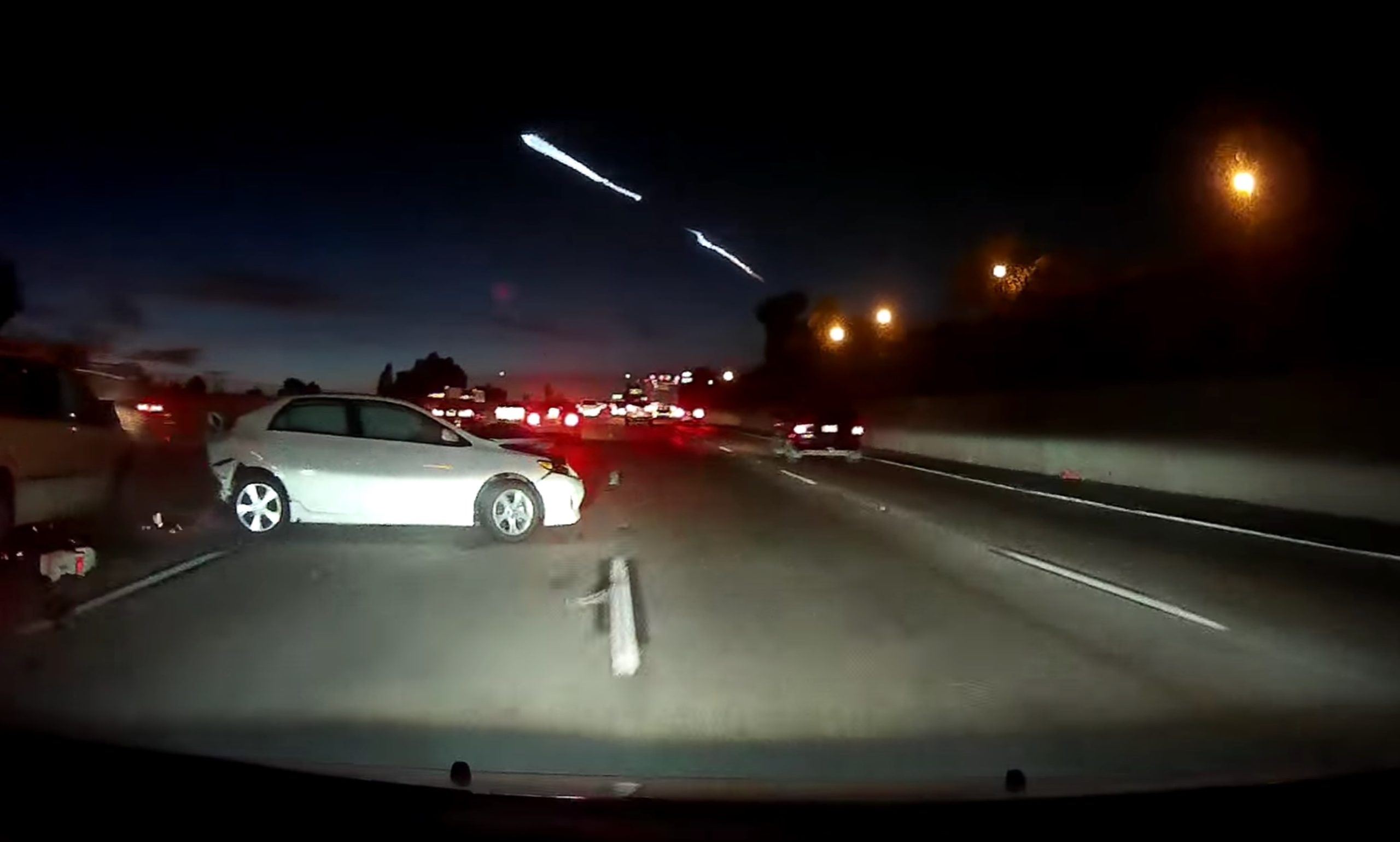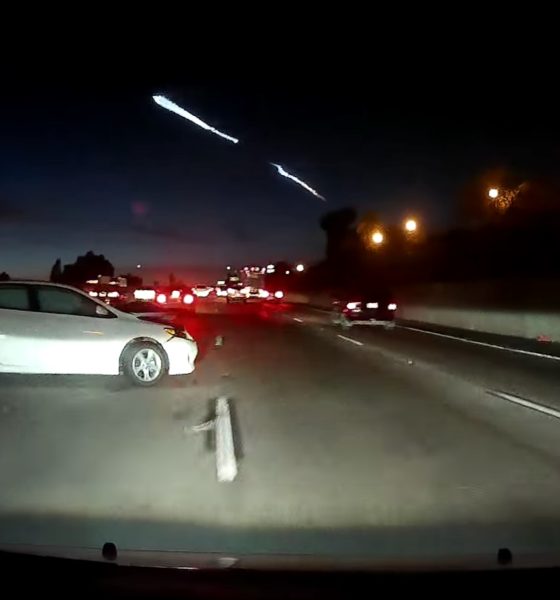

News
Odd sighting from SpaceX rocket launch leads to highway crash
SpaceX’s last Falcon 9 launch of 2017, which carried yet another batch of Iridium satellites into space, was particularly stunning. The launch was so visually spectacular, in fact, that it ultimately caused a three-car pileup on Interstate 10 in Beaumont, located roughly 80 miles east of Los Angeles.
The incident was caught on tape and shared on YouTube by Mark Sales, who was traveling on the highway with his family. In a dashcam video recording of the incident, Sales and his family could be heard excitedly talking about the aerial display, with people in the vehicle audibly wondering what it could be.
As could be seen in the video, several drivers on the highway seemed to have gotten transfixed by the event. Not long after, a mid-sized SUV braked suddenly, causing a compact sedan to slam on its brakes as well. Unfortunately, a crossover SUV was not able to slow down on time, causing it to violently slam into the sedan, which in turn crashed into the mid-sized SUV.
The impact from the accident was so violent that the compact sedan was totaled and thrown across the road and into another lane. The mid-sized SUV was also pushed to the curb due to the impact. Details about the crash remain unknown, however, as Sales opted to move along after the incident, seemingly as a way to prevent a possible traffic jam.
Rocket launches are always quite the spectacle, and SpaceX, which conducts missions fairly frequently, has managed to freak people out on more than one occasion. The aerial displays that ensue after that the launch of the private space firm’s rockets, for one, have managed to consistently grab the attention of people from all walks of life, from random bystanders to dedicated UFO enthusiasts.
Last Friday’s mission, however, was a little bit special. Due to the launch occurring around 30 minutes after the sunset, the exhaust plume of the spacecraft was illuminated at high altitude by the sun, resulting in an aerial display that could only be described as atmospheric art. The trails left by the Falcon 9 rocket were so prominent in the sky; even Hollywood stars took to Twitter to excitedly discuss the event, as noted in a Vanity Fair report.
Unsurprisingly, the spectacle also attracted several alien enthusiasts, many of which speculated on possible UFO sightings. True to form, SpaceX CEO Elon Musk decided to add a little joke to the ongoing discussions, stating that the lights in the sky were definitely caused by aliens.
It was definitely aliens
— Elon Musk (@elonmusk) December 23, 2017
Considering that SpaceX is preparing to launch the “world’s most powerful rocket” that will be carrying Musk’s personal Tesla Roadster into space, there is a pretty good chance that the trails it would leave in the sky would be even more prominent than the ones left by its smaller Falcon 9 siblings. In order to prevent a similar accident from happening, SpaceX would need to thoroughly warn everyone in the area about the massive rocket’s launch. Otherwise, more fun discussions about aliens, and other non-fun road incidents, might happen once more.

News
Tesla FSD fleet is nearing 7 billion total miles, including 2.5 billion city miles
As can be seen on Tesla’s official FSD webpage, vehicles equipped with the system have now navigated over 6.99 billion miles.

Tesla’s Full Self-Driving (Supervised) fleet is closing in on almost 7 billion total miles driven, as per data posted by the company on its official FSD webpage.
These figures hint at the massive scale of data fueling Tesla’s rapid FSD improvements, which have been quite notable as of late.
FSD mileage milestones
As can be seen on Tesla’s official FSD webpage, vehicles equipped with the system have now navigated over 6.99 billion miles. Tesla owner and avid FSD tester Whole Mars Catalog also shared a screenshot indicating that from the nearly 7 billion miles traveled by the FSD fleet, more than 2.5 billion miles were driven inside cities.
City miles are particularly valuable for complex urban scenarios like unprotected turns, pedestrian interactions, and traffic lights. This is also the difference-maker for FSD, as only complex solutions, such as Waymo’s self-driving taxis, operate similarly on inner-city streets. And even then, incidents such as the San Francisco blackouts have proven challenging for sensor-rich vehicles like Waymos.
Tesla’s data edge
Tesla has a number of advantages in the autonomous vehicle sector, one of which is the size of its fleet and the number of vehicles training FSD on real-world roads. Tesla’s nearly 7 billion FSD miles then allow the company to roll out updates that make its vehicles behave like they are being driven by experienced drivers, even if they are operating on their own.
So notable are Tesla’s improvements to FSD that NVIDIA Director of Robotics Jim Fan, after experiencing FSD v14, noted that the system is the first AI that passes what he described as a “Physical Turing Test.”
“Despite knowing exactly how robot learning works, I still find it magical watching the steering wheel turn by itself. First it feels surreal, next it becomes routine. Then, like the smartphone, taking it away actively hurts. This is how humanity gets rewired and glued to god-like technologies,” Fan wrote in a post on X.
News
Tesla starts showing how FSD will change lives in Europe
Local officials tested the system on narrow country roads and were impressed by FSD’s smooth, human-like driving, with some calling the service a game-changer for everyday life in areas that are far from urban centers.

Tesla has launched Europe’s first public shuttle service using Full Self-Driving (Supervised) in the rural Eifelkreis Bitburg-Prüm region of Germany, demonstrating how the technology can restore independence and mobility for people who struggle with limited transport options.
Local officials tested the system on narrow country roads and were impressed by FSD’s smooth, human-like driving, with some calling the service a game-changer for everyday life in areas that are far from urban centers.
Officials see real impact on rural residents
Arzfeld Mayor Johannes Kuhl and District Administrator Andreas Kruppert personally tested the Tesla shuttle service. This allowed them to see just how well FSD navigated winding lanes and rural roads confidently. Kruppert said, “Autonomous driving sounds like science fiction to many, but we simply see here that it works totally well in rural regions too.” Kuhl, for his part, also noted that FSD “feels like a very experienced driver.”
The pilot complements the area’s “Citizen Bus” program, which provides on-demand rides for elderly residents who can no longer drive themselves. Tesla Europe shared a video of a demonstration of the service, highlighting how FSD gives people their freedom back, even in places where public transport is not as prevalent.
What the Ministry for Economic Affairs and Transport says
Rhineland-Palatinate’s Minister Daniela Schmitt supported the project, praising the collaboration that made this “first of its kind in Europe” possible. As per the ministry, the rural rollout for the service shows FSD’s potential beyond major cities, and it delivers tangible benefits like grocery runs, doctor visits, and social connections for isolated residents.
“Reliable and flexible mobility is especially vital in rural areas. With the launch of a shuttle service using self-driving vehicles (FSD supervised) by Tesla in the Eifelkreis Bitburg-Prüm, an innovative pilot project is now getting underway that complements local community bus services. It is the first project of its kind in Europe.
“The result is a real gain for rural mobility: greater accessibility, more flexibility and tangible benefits for everyday life. A strong signal for innovation, cooperation and future-oriented mobility beyond urban centers,” the ministry wrote in a LinkedIn post.
News
Tesla China quietly posts Robotaxi-related job listing
Tesla China is currently seeking a Low Voltage Electrical Engineer to work on circuit board design for the company’s autonomous vehicles.

Tesla has posted a new job listing in Shanghai explicitly tied to its Robotaxi program, fueling speculation that the company is preparing to launch its dedicated autonomous ride-hailing service in China.
As noted in the listing, Tesla China is currently seeking a Low Voltage Electrical Engineer to work on circuit board design for the company’s autonomous vehicles.
Robotaxi-specific role
The listing, which was shared on social media platform X by industry watcher @tslaming, suggested that Tesla China is looking to fill the role urgently. The job listing itself specifically mentions that the person hired for the role will be working on the Low Voltage Hardware team, which would design the circuit boards that would serve as the nervous system of the Robotaxi.
Key tasks for the role, as indicated in the job listing, include collaboration with PCB layout, firmware, mechanical, program management, and validation teams, among other responsibilities. The role is based in Shanghai.
China Robotaxi launch
China represents a massive potential market for robotaxis, with its dense urban centers and supportive policies in select cities. Tesla has limited permission to roll out FSD in the country, though despite this, its vehicles have been hailed as among the best in the market when it comes to autonomous features. So far, at least, it appears that China supports Tesla’s FSD and Robotaxi rollout.
This was hinted at in November, when Tesla brought the Cybercab to the 8th China International Import Expo (CIIE) in Shanghai, marking the first time that the autonomous two-seater was brought to the Asia-Pacific region. The vehicle, despite not having a release date in China, received a significant amount of interest among the event’s attendees.








